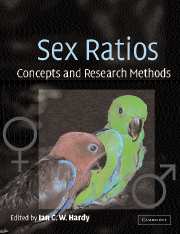Book contents
- Frontmatter
- Contents
- List of contributors
- Preface and acknowledgements
- Part 1 Sex ratio theory
- Part 2 Statistical analysis of sex ratio data
- Part 3 Genetics of sex ratio and sex determination
- Chapter 7 Sex-determining mechanisms in vertebrates
- Chapter 8 Sex determination in invertebrates
- Chapter 9 Sex ratio distorters and their detection
- Part 4 Animal sex ratios under different life-histories
- Part 5 Sex ratios in plants and protozoa
- Part 6 Applications of sex ratios
- Index
- References
Chapter 7 - Sex-determining mechanisms in vertebrates
Published online by Cambridge University Press: 06 August 2009
- Frontmatter
- Contents
- List of contributors
- Preface and acknowledgements
- Part 1 Sex ratio theory
- Part 2 Statistical analysis of sex ratio data
- Part 3 Genetics of sex ratio and sex determination
- Chapter 7 Sex-determining mechanisms in vertebrates
- Chapter 8 Sex determination in invertebrates
- Chapter 9 Sex ratio distorters and their detection
- Part 4 Animal sex ratios under different life-histories
- Part 5 Sex ratios in plants and protozoa
- Part 6 Applications of sex ratios
- Index
- References
Summary
Summary
Vertebrates have various sex-determining mechanisms. These have been broadly classified as either genotypic sex determination (GSD) or environmental sex determination (ESD). This terminology, however, may obscure the facts that mixtures between genotypic and environmental sex determination exist, and that genotypic and environmental sex determination may themselves be the extremes of a continuum. Sex ratio evolution plays an important role in the evolution of sex-determining mechanisms.
Introduction
This chapter starts with the proximate aspects of sex-determining mechanisms (section 7.3). We introduce the traditional classification of sex-determining mechanisms that exist in vertebrates (section 7.3.1) and the distribution of mechanisms among extant vertebrate taxa (section 7.3.2). At phylogenetically shallow levels, different mechanisms are present. We describe how the existence of either male or female heterogamety, or ESD is usually established for individual species or taxa (section 7.3.3). Cases of mixed sex determination, i.e. combinations of GSD and ESD, are also observed (section 7.3.4) and we caution that this phenomenon has implications for sex identification by molecular markers (section 7.3.5). We stress that phenotypic sex generally has environmental and genetic components and discuss a model that attempts to unify sex determination by stating that sex determination in all vertebrates is mediated by differential growth of the embryo (section 7.3.6).
In the second part of the chapter we discuss the evolution of sex-determining mechanisms. Evolution from one system to another can be quite rapid (section 7.4). We stress that sex ratio selection plays an important role in the evolution of sex-determining mechanisms (section 7.4.1).
- Type
- Chapter
- Information
- Sex RatiosConcepts and Research Methods, pp. 158 - 177Publisher: Cambridge University PressPrint publication year: 2002
References
- 38
- Cited by



